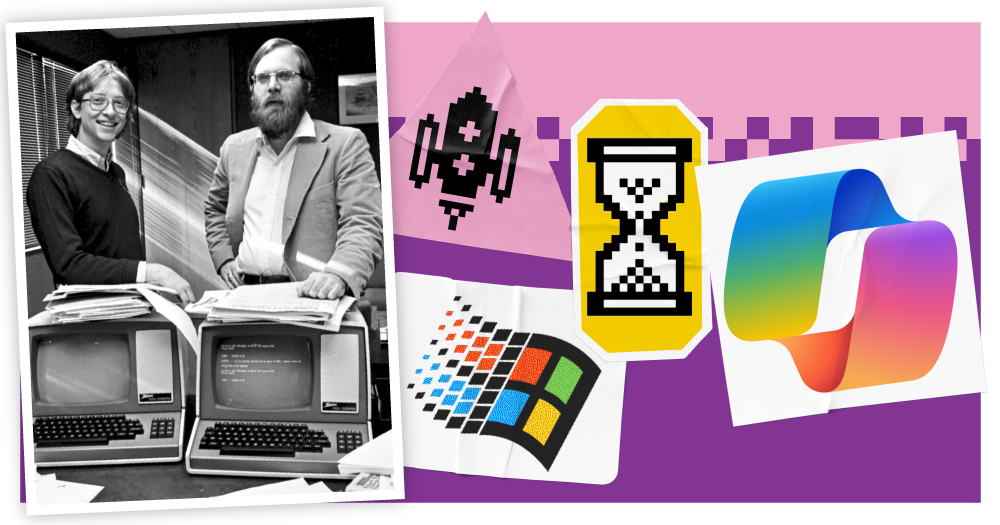Key takeaways
- Microsoft was founded in 1975 by Bill Gates and Paul Allen, starting with software for early personal computers.
- Over the decades, it evolved from MS-DOS and Windows to becoming a global leader in cloud computing, AI and enterprise solutions.
- Today, Microsoft powers modern work through platforms like Microsoft 365, Azure and Copilot, shaping the future of technology and business.
Microsoft has long been a behemoth in the world of technology. Since its inception in 1975, the company has empowered businesses and individuals with cutting-edge solutions.
Technology has evolved leaps and bounds since 1975, but so has Microsoft. In every era, it has brought the latest innovations to the market: from word processing in the 1980s to AI assistance in the 2020s.
We’ve put together a comprehensive timeline of Microsoft’s history to show how it has evolved over the last 60 years.
1975: the origins of Microsoft_
Microsoft was founded in 1975 by Bill Gates and Paul Allen in New Mexico. The company was sparked when the pair read an article about the Altair 8800, one of the first personal computers. They saw an opportunity to enter the technology market.
Their initial product was a BASIC interpreter for the Altair 8800 microcomputer. After overcoming challenges with memory and processing power, the product successfully hit the market, marking Microsoft as an early pioneer in the world of technology.
1980-1990: MS-DOS and IBM_
The year 1980 was a turning point for Microsoft. The company entered a pivotal partnership with IBM to develop the operating system for the IBM PC.
While Microsoft wasn’t the sole developer and didn’t write the OS, they licensed and modified an existing one, rebranding it as MS-DOS (Microsoft Disk Operating System).
MS-DOS became the standard operating system for PC compatibles, used in countless computers and giving software developers a platform to design their solutions for. Its command-line interface provided a basic framework for running software and managing files. It is also credited with fuelling the computer revolution as more people bought PCs for personal use.
Most crucially, MS-DOS pushed Microsoft to a dominant position within the software industry and paved the road for its future innovations.
1990-2000: The Windows era_
Windows is synonymous with Microsoft. Realising the limitations of MS-DOS, Microsoft endeavoured to create a user-friendly operating system. Windows 1 was released in 1985, with a further release coming in 1987.
By 1990, we had Windows 3, which was a breakthrough for the software. While the earlier versions showed the world what a mouse-based interface with multitasking capabilities looked like, Windows 3 offered a more polished interface, better performance and wider application support. It made Windows popular across the world, staving off competition from Apple.
Also in 1990, we saw the launch of Office, initially including Word, Excel and PowerPoint. These three tools had already been developed by Microsoft, but Office bundled them together into one packaged solution to suit both individuals and businesses.
The release of Windows and Office marked Microsoft’s ability to evolve with the needs of its customers. The fact they both continue today (with Windows 11 and Microsoft 365) shows the forward-thinking of the company.
1995 also brought the release of Internet Explorer, which was at one point the market dominator. However, this left Microsoft in hot water.
The U.S. Department of Justice filed an antitrust lawsuit against Microsoft in 1998, alleging that the company had abused its monopoly in the operating system market to stifle competition in the browser market.
While Microsoft survived the incident relatively unscathed, it forced the company to rethink its business strategy to meet changes in regulation and avoid future lawsuits.
2000-2010: Internet and cloud computing_
The early 2000s were a trying time for Microsoft as the dot-com bubble burst, leaving many online and software companies unable to survive. There was also increased competition against Internet Explorer, which made it difficult for Microsoft to maintain dominance.
Microsoft made it through these storms, but had to adapt their products to meet the changing market.
In this era, Microsoft expanded into server software including SQL Server, Exchange Server and SharePoint. With a growth in enterprise computing, these became significant revenue streams for the company.
In 2003, Dynamics CRM was also launched under the name Microsoft Business Solutions Customer Relationship Management 1.0. It would become known as Dynamics in 2005, aligning the CRM to Microsoft’s Dynamics ERP solution.
The CRM saw Microsoft once again extending their market reach, targeting businesses of all sizes that required customer relationship management solutions.
And this wasn’t the only way Microsoft entered a new market. They launched their first gaming console in 2001, the Xbox, to challenge the likes of Sony and Nintendo. This was followed by the Xbox 360 in 2005. Xbox continues to be a leader within the gaming industry today.
2010-2020: Transforming for mobile and cloud_
This era saw Microsoft investing in the modern technologies that are commonplace today.
Azure launched in 2010, seeing Microsoft shifting towards cloud computing. It was marketed as a rival to Amazon Web Services and offered a vast array of options for customers, including PaaS, SaaS and IaaS.
Office also became known as Office 365 in 2011 and was relaunched as a cloud-based subscription service, putting further emphasis on the cloud. Later in 2017, Microsoft 365 was launched as a subscription service comprising Office 365, Windows 10 and Enterprise Mobility + Security. Today, Office 365 has merged into Microsoft 365 for a cloud-based productivity suite that many businesses still rely on.
A new product that came in this phase was Power Platform, launched in 2017. It gave businesses a low-code solution for building business applications and automations, making innovation more accessible.
Microsoft also began to heavily invest in artificial intelligence, with products like Cortana and mixed reality with devices like HoloLens coming on the market.
Once again, it wasn’t all good news. Microsoft also attempted to enter the mobile market with Windows Phone in 2010. However, it struggled to compete and eventually declined off the market.
Of course, one of the most significant events in this time was the coronavirus pandemic in 2020. As people entered lockdown, there was a shift towards home and hybrid work. For several organisations, this was a catalyst for digital transformation within their operations.
Microsoft was at the forefront of this change. Their cloud-based services became increasingly popular, allowing people to be productive from any location. Microsoft Teams had explosive growth as people sought to stay connected from afar.
In response to the pandemic, Microsoft also began to dedicate more research into the future of work, as well as supporting employee wellbeing initiatives.
2020-present: The AI revolution_
Today, Microsoft remains a leader in the business technology field.
Products like Microsoft 365 and Dynamics 365 continue to be staples for organisations, enabling them to work smarter, improve efficiency and facilitate collaboration across departments.
In the modern day, innovation has taken a much bigger priority for businesses. Power Platform has taken on a new precedent, enabling organisations to evolve their operations and embrace opportunities with low-code tools.
However, one of the biggest changes for Microsoft has been the rise of AI. In 2023, Copilot was launched, delivering Microsoft’s first AI assistant to the public. Copilot is now infused across their products, enabling businesses to gain the productivity benefits of AI in the tools they’re most familiar with.
As AI continues to dominate the world, Microsoft have kept investing in it. 2024 saw the launch of Copilot for Security, the first generative AI security product.
Microsoft also releases twice-yearly updates across their products, bringing new functionality for users to enjoy. The updates are the result of cutting-edge research and development, enabling businesses to stay on top of the technological wave and optimise their operations.
The company shows no signs of stopping, so we can expect more market-leading and AI-powered developments to come in Microsoft’s next era.
Embrace the might of Microsoft_
With decades of experiencing in delivering intelligent business solutions to the market, Microsoft is a name you can trust.
If you want to embed the power of Microsoft within your business and tackle internal challenges, we can help. Our expert consultants have knowledge across Microsoft’s modern solutions, including Microsoft 365, Dynamics 365, Copilot, Power Platform and more. We were even named a finalist for Microsoft’s Partner of the Year in 2024.
Using our knowledge, we can help you to discover the best solutions for your needs and overcome current challenges, with evergreen rewards for your business.




